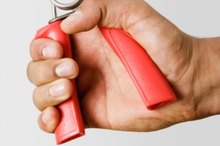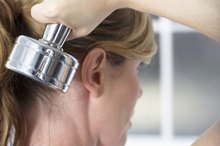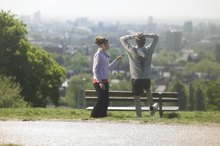A Rehabilitation Exercise for a Pulled Biceps Muscle
A pulled bicep muscle can be excruciatingly painful, limiting your mobility and causing swelling in your arm. Before you begin rehabilitation exercises, though, you'll need to check with your doctor to ensure you don't have a broken bone, torn tendon or a serious muscular injury that requires surgery. Your doctor can tell you when it's safe to start rehabilitation exercises, and until you have permission to do so, you should practice rest, ice, compression and elevation to reduce swelling and inflammation.
Trigger Point Massage
Before you begin exercising your bicep, try trigger point massage to reduce pain, swelling and stiffness in the muscle. Gently massage your bicep, looking for muscle knots or hardened muscles. When you find them, press on them -- massaging in one direction only -- while slowly bending your elbow to improve your range of motion. As you bend your elbow, your hand should move up toward your shoulder. Repeat twice a day until you notice that pain is improving. On the first day, massage gently, but gradually increase the pressure you apply to muscle knots on each subsequent day. Massage should be uncomfortable but should not be unbearably painful.
- Before you begin exercising your bicep, try trigger point massage to reduce pain, swelling and stiffness in the muscle.
Biceps Stretches
How to Treat Hamstring Tweaks
Learn More
Stretching your bicep can encourage the muscle to heal and reduce tension, but you should never force an uncomfortable stretch. Face a wall, and extend your arm straight out so that your hand touches the wall. Slowly rotate your body away from your arm until you feel a stretch. Hold for 30 seconds, then stand up straight with your arms behind you. Clasp your hands together, and raise your hands up until you feel a stretch. Hold for another 30 seconds.
- Stretching your bicep can encourage the muscle to heal and reduce tension, but you should never force an uncomfortable stretch.
- Slowly rotate your body away from your arm until you feel a stretch.
Weight Training
A simple weight-bearing exercise can help you gain strength in your bicep and prevent the muscle from atrophying as it heals. Stand up straight and hold a small hand weight in your hand. With your arm pointed downward, bend your elbow and slowly lift the weight toward your shoulder in a bicep curl. Perform five to 10 reps, and as you gain strength, increase the amount of weight you use.
- A simple weight-bearing exercise can help you gain strength in your bicep and prevent the muscle from atrophying as it heals.
- With your arm pointed downward, bend your elbow and slowly lift the weight toward your shoulder in a bicep curl.
Rotations
Wrist Exercises After Surgery
Learn More
Rotations can help improve your range of motion while gently stretching your muscles. Lie on the side of the arm that is not injured, and bend your injured arm at your elbow, forming a 90-degree angle. Lift your arm toward the ceiling while keeping your elbow pressed up against your side. Hold for two to five seconds, then lower your arm. Aim for one to two sets of 15 reps. As you gain strength, try adding a hand weight or soup can to increase the difficulty of the routine.
- Rotations can help improve your range of motion while gently stretching your muscles.
- Lie on the side of the arm that is not injured, and bend your injured arm at your elbow, forming a 90-degree angle.
Related Articles
References
- The Trigger Point Therapy Workbook; Claire Davies et al.
- Summit Medical Group: Biceps Tendon Injury Exercises
- University of Wisconsin Sports Medicine: Rehabilitation Guidelines for Biceps Tenodesis
- ExRx.net: Standing Biceps Stretch
- Behm D, Chaouachi A. A review of the acute effects of static and dynamic stretching on performance. Eur J Appl Physiol. 2011;111(11):2633-2651. doi:10.1007/s00421-011-1879-2
- Page P. Current concepts in muscle stretching for exercise and rehabilitation. Int J Sports Phys Ther. 2012;7(1):109–119.
- Sources: Apostolopoulos N, Metsios GS, Flouris AD, Koutedakis Y, Wyon MA. The relevance of stretch intensity and position-a systematic review. Front Psychol. 2015;6:1128. Published 2015 Aug 18. doi:10.3389/fpsyg.2015.01128
- Turpin NA, Levin MF, Feldman AG. Implicit learning and generalization of stretch response modulation in humans. J Neurophysiol. 2016;115(6):3186–3194. doi:10.1152/jn.01143.2015
- Zöllner A, Abilez O, Böl M, Kuhl E. Stretching Skeletal Muscle: Chronic Muscle Lengthening through Sarcomerogenesis. PLoS ONE. 2012;7(10):e45661. doi:10.1371/journal.pone.0045661
Writer Bio
Van Thompson is an attorney and writer. A former martial arts instructor, he holds bachelor's degrees in music and computer science from Westchester University, and a juris doctor from Georgia State University. He is the recipient of numerous writing awards, including a 2009 CALI Legal Writing Award.









